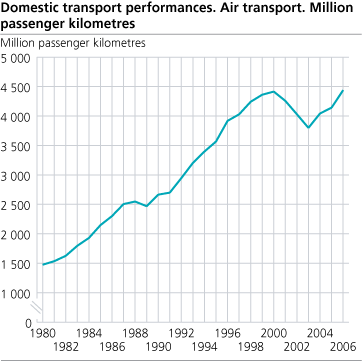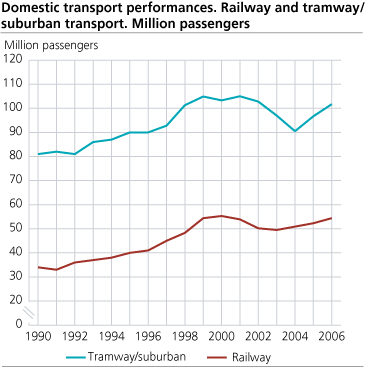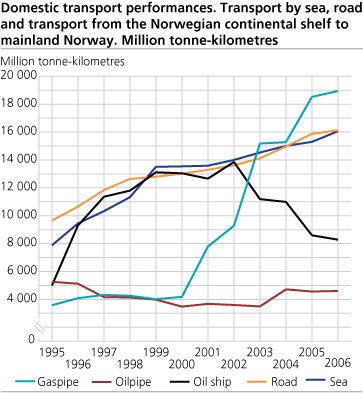Content
Published:
This is an archived release.
Strong tail wind for the air transport
10.2 million domestic passengers travelled by air in 2006, an increase of seven per cent. or 0.7 million passengers, compared with 2005. The transport work for the road transport was more or less unchanged in 2006 compared with 2005.
The passenger transport by air experienced a continuous growth until 2000, before the decline as from 2001. From 2000 until 2003 the number of passenger kilometres was reduced by 14 per cent to scarcely 3.8 billion passenger kilometres. The statistics as from 2004 show new growth for this sector, but not until 2006 the traffic constituted at the same level as in 2000. In 2006, 10.2 billion domestic passengers travelled by air, and the transport performances came to 4.4 billion passenger kilometres.
More passengers use public transport
Also the rest of the public transport shows an increase in 2006 measured in passengers travelled compared with 2005. The transport by bus experienced only a minor increase though (0.7 per cent), but the railroad vehicles had a considerable growth for the second connected year. As for the transport by air, the passenger transport by railroad vehicles also found itself at the same level of transport as at the change of millennium. The passengers by rail constituted somewhat above 54 million in 2006, an increase by four per cent compared with 2005. In the same period, the traffic by the suburban railways and urban tramways increased by five per cent to almost 102 million passengers in 2006.
Insignificant change in passenger kilometres performed by road vehicles
Though the transport by road shows an increase in the number of travels in 2006 of almost 2 per cent, the statistics still indicate an insignificant growth in the passenger kilometres performed. However, the transport by motorcycles and mopeds increased in 2006 compared with 2005. The increase came to five per cent and the passenger kilometres constituted almost 1.5 billion in 2006. Both taxies and transport by bus experienced a minor decrease in passenger kilometres performed in 2006. The use of rental cars and private cars were more or less unchanged compared to 2005. As a comparison, from 1995 to 2005 the transport performances for private cars increased by almost 18 per cent, or 8 billion passenger kilometres, to 51.4 billion passenger kilometres. In 2006 the transport work was estimated to 51.5 billion passenger kilometres, i.e. a negligible growth from 2005.
Three out of four passenger kilometres done by private car
Though the overall average trip length per inhabitant was unchanged in 2006 compared with 2005 (39.6 kilometres), the same dimension shows a decrease for the private car to 30.3 kilometres in 2006. This was mainly due to an increase in the population of barely one per cent in 2006. Still, the private cars constituted a share of 76 per cent of the total passenger kilometres performed in 2006.
|
Domestic transport performances. Number of passenger kilometres per
inhabitants per day |
| Total | Private cars | Other passenger tranport | Air | Railway1 | Water transport | ||||||||||||||||||||||||||||||||||
|---|---|---|---|---|---|---|---|---|---|---|---|---|---|---|---|---|---|---|---|---|---|---|---|---|---|---|---|---|---|---|---|---|---|---|---|---|---|---|---|
| 1946 | 4.04 | 0.93 | 0.88 | 0.00 | 1.83 | 0.40 | |||||||||||||||||||||||||||||||||
| 1952 | 5.67 | 1.31 | 2.04 | 0.01 | 1.86 | 0.45 | |||||||||||||||||||||||||||||||||
| 1960 | 9.72 | 3.65 | 3.51 | 0.08 | 1.99 | 0.49 | |||||||||||||||||||||||||||||||||
| 1965 | 13.89 | 7.43 | 3.93 | 0.25 | 1.78 | 0.50 | |||||||||||||||||||||||||||||||||
| 1970 | 18.32 | 12.61 | 3.44 | 0.45 | 1.37 | 0.45 | |||||||||||||||||||||||||||||||||
| 1975 | 24.14 | 17.99 | 3.45 | 0.70 | 1.55 | 0.45 | |||||||||||||||||||||||||||||||||
| 1980 | 27.29 | 20.41 | 3.61 | 0.99 | 1.84 | 0.44 | |||||||||||||||||||||||||||||||||
| 1985 | 31.44 | 24.34 | 3.57 | 1.42 | 1.69 | 0.42 | |||||||||||||||||||||||||||||||||
| 1990 | 34.81 | 27.58 | 3.49 | 1.72 | 1.57 | 0.45 | |||||||||||||||||||||||||||||||||
| 1995 | 35.28 | 27.44 | 3.49 | 2.24 | 1.68 | 0.43 | |||||||||||||||||||||||||||||||||
| 1996 | r36,74 | 28.27 | 3.81 | 2.46 | 1.74 | 0.46 | |||||||||||||||||||||||||||||||||
| 1997 | 36.90 | 27.92 | 4.15 | 2.51 | 1.83 | 0.49 | |||||||||||||||||||||||||||||||||
| 1998 | 37.73 | 28.30 | 4.41 | 2.62 | 1.89 | 0.51 | |||||||||||||||||||||||||||||||||
| 1999 | 37.91 | 28.11 | 4.49 | 2.68 | 2.10 | 0.53 | |||||||||||||||||||||||||||||||||
| 2000 | 38.43 | 28.57 | 4.60 | 2.70 | 2.04 | 0.52 | |||||||||||||||||||||||||||||||||
| 2001 | 38.63 | 29.08 | 4.47 | 2.58 | 1.99 | 0.51 | |||||||||||||||||||||||||||||||||
| 2002 | 38.98 | 29.81 | 4.42 | 2.43 | 1.80 | 0.52 | |||||||||||||||||||||||||||||||||
| 2003 | 39.11 | 30.29 | 4.29 | 2.28 | 1.74 | 0.51 | |||||||||||||||||||||||||||||||||
| 2004 | 39.33 | 30.24 | 4.35 | 2.41 | 1.83 | 0.50 | |||||||||||||||||||||||||||||||||
| 2005 | r39,64 | r30,46 | r4,33 | 2.45 | 1.90 | 0.50 | |||||||||||||||||||||||||||||||||
| 2006 | 39.63 | 30.27 | 4.31 | 2.61 | 1.94 | 0.50 | |||||||||||||||||||||||||||||||||
| 1 | Including suburban railways and urban tramways. |
Photo-finish between sea and road
The difference in the domestic transport work performed by road versus water transport, came to barely 0.4 per cent in 2006. This year both modes of transport each performed more than 16 billion tonne-kilometres. The increase compared to 2005 was two and five per cent for the road and water transport, respectively.
Measured in tonnes transported however, the domestic transport by road vehicles outdid the water transport by 3:1. The similarity in transport work performed and dissimilarity in tonnes transported as basis, hence it follows that the average length of transport of goods by sea, is about triple the average length by road vehicles.
Gas transport by pipeline keeps the dominant position
The transport of gas by pipeline from the Norwegian continental shelf to the Norwegian mainland, exceeded both the transport by road and by sea in 2003, consolidated the position in 2004-2005 and experienced the same increase in 2006 as did the road transport, i.e. about two per cent increase. This mode of transport came to 18.9 billion tonne-kilometres in 2006.
The transport from the Norwegian continental shelf to the terminals on the Norwegian mainland totalled 31.8 billion tonne-kilometres in 2006, or a share of almost 48 per cent of the total transport work this year. If the comparison is based on tonnes transported instead, the share referred to drop to 25 per cent of the total domestic transport performances.
Tables:
Contact
-
Geir Martin Pilskog
E-mail: geir.martin.pilskog@ssb.no
tel.: (+47) 40 81 13 83



